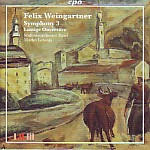Beethoven’s “Eroica” teaches all subsequent generations of composers a critical lesson: the longer the work, the more clear-cut the large-scale form needs to be, and the broader the scheme of contrasts. Different composers who “wrote long” have achieved this in different ways: Bruckner minimized transitions and organized his material in well-defined blocks of sound. Mahler employed a vast and eclectic range of musical ideas and gestures. Strauss wrote tone-poems with fanciful subject matter so as to maximize contrasts in orchestral color. One way or another, it has to happen, and when it doesn’t you wind up with something along the lines of Weingartner’s Third Symphony, a lovely work from one moment to the next, but a big mess when taken as a whole.
The first movement, for example, is marked “allegro con brio”, but there’s very little “brio” evident in its 16 minutes. This may be a fault of the performance to some degree, but the stop-and-start quality of the themes is inherent in their shape, and so unavoidable. Nevertheless, the music is extremely attractive as it stands, and beautifully scored, with some particularly colorful woodwind writing and a nice feeling of freshness. You want to love it, and other listeners may be more successful at the attempt than I was. Unfortunately, the not very “con brio” first movement precedes a moderately paced scherzo, followed by 18 minutes of adagio, and it’s all rounded off by a finale of similar length.
That’s 65 minutes in all, and by the time you get to the end you could be forgiven for feeling that it all sounds much the same. The symphony lacks an effective scheme of contrasts that sustains more than an hour of nearly continuous listening (even the notes describe it as a musical “mollusk”). Evidently, Weingartner just didn’t have it in him, or didn’t recognize the problem. What he did have was plenty of smaller-scaled compositional talent. For example, in German music anything with the word “Lustig” (“Merry”) in its title is almost always asking for trouble. The only less “Lustig” school of composition has to be the Russian, but Weingartner actually pulls it off. Sure, there are the usual cute bits for gurgling bassoons and chirping piccolos, but beyond that he devises emotionally specific themes and episodes that drive this good-natured music along to a spirited conclusion. It’s a charming work, and more to the point, one containing more contrast and variety than the entire symphony.
Perhaps in the symphony Weingartner was trying too hard: symphonies so often bring out the worst in composers, particularly late-Romantics of the German school who mistake seriousness for sententiousness. It’s all the more frustrating that the performances for the most part sound quite lovely (if a bit careful), are very well engineered, and certainly do more than enough to give listeners an excellent sense of what this music is about. Fans of big, effusive, late-Romantic German symphonies will want this, but it’s becoming increasingly clear why Weingartner’s music hasn’t caught on, despite its kind demeanor and all the evident skill that went into its fabrication.
































